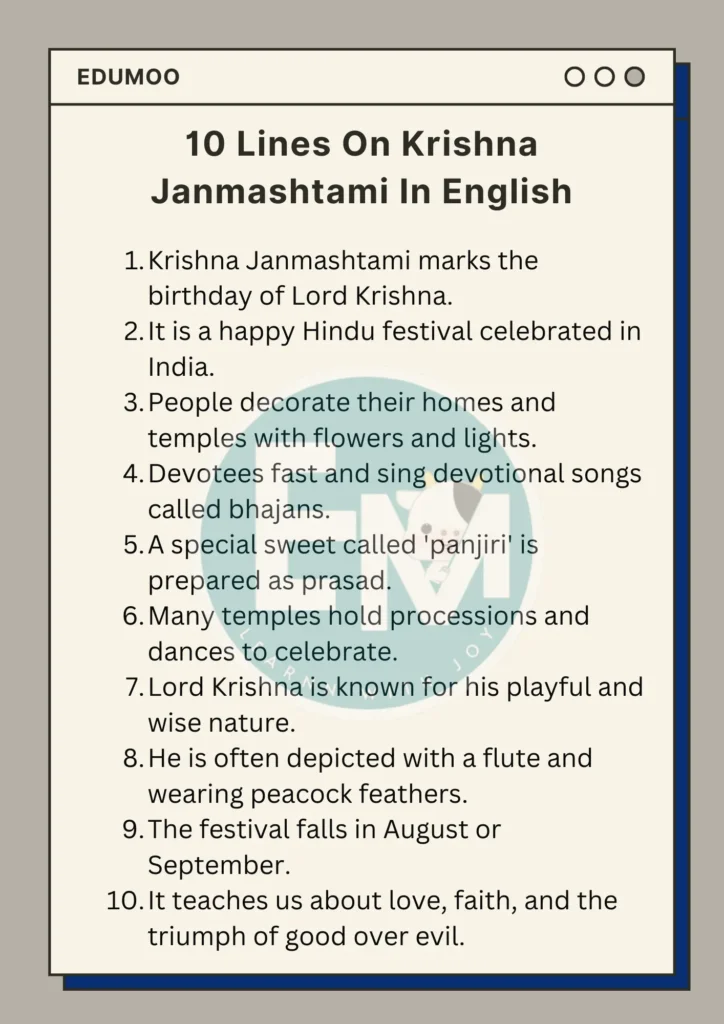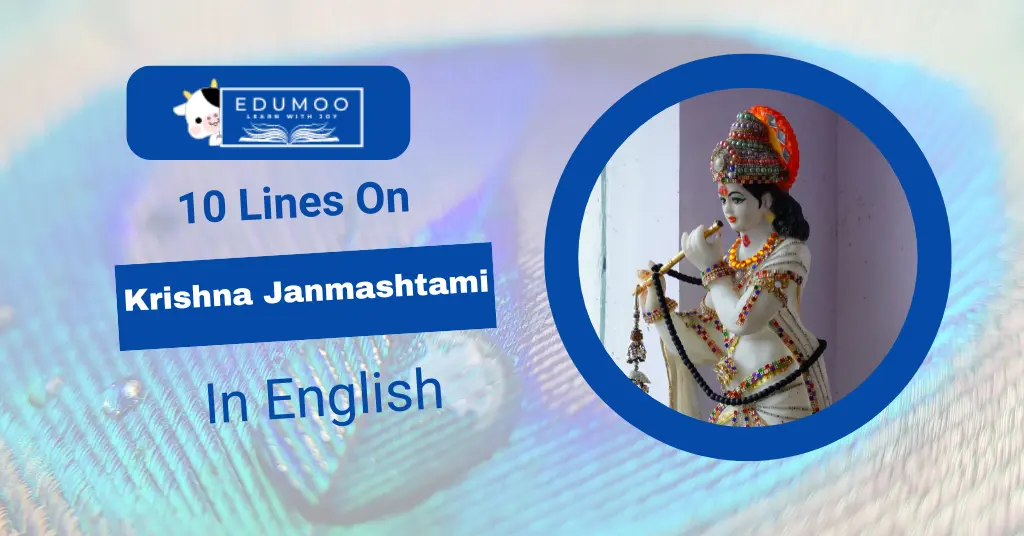Krishna Janmashtami is a colorful and joyful festival celebrated all across India. It marks the birthday of Lord Krishna, who is a beloved deity in Hindu mythology. During this festival, people decorate their homes and temples with bright flowers and lights. Devotees fast and sing special songs to praise Lord Krishna. It’s a time of happiness and devotion, where families come together to celebrate. Let’s explore more about 10 lines on Krishna Janmashtami and learn why it’s so important in Indian culture.
10 Lines On Krishna Janmashtami In English
- Krishna Janmashtami marks the birthday of Lord Krishna.
- It is a happy Hindu festival celebrated in India.
- People decorate their homes and temples with flowers and lights.
- Devotees fast and sing devotional songs called bhajans.
- A special sweet called ‘panjiri’ is prepared as prasad.
- Many temples hold processions and dances to celebrate.
- Lord Krishna is known for his playful and wise nature.
- He is often depicted with a flute and wearing peacock feathers.
- The festival falls in August or September.
- It teaches us about love, faith, and the triumph of good over evil.

Essay On Krishna Janmashtami In English In 300 Words
Krishna Janmashtami is a special Hindu festival celebrated to honor the birth of Lord Krishna, who is considered the eighth avatar of Lord Vishnu. This festival typically takes place in August or September. Lord Krishna was born in Mathura to his parents, Devaki and Vasudeva. His birth is believed to have taken place at midnight, which is why this festival is also known as Janmashtami or Gokulashtami.
During Krishna Janmashtami, people decorate their homes and temples with colorful flowers and lights. They also make beautiful patterns called rangoli at their doorsteps. Devotees fast on this day and spend time singing devotional songs called bhajans in praise of Lord Krishna. Special prayers and ceremonies are held in temples to celebrate his birth.
One of the most famous rituals of Krishna Janmashtami is ‘Dahi Handi’. It reenacts the playful nature of young Krishna, who loved stealing butter. In this ritual, a pot filled with curd, butter, and other goodies is suspended high above the ground. Teams of young men and boys form human pyramids to reach and break the pot. It’s a fun and challenging activity that symbolizes unity and teamwork.
Krishna Janmashtami teaches important lessons. Lord Krishna, known for his wisdom and bravery, showed people the path of righteousness and truth through his actions and teachings in the Bhagavad Gita. His life inspires people to fight against injustice and uphold good values. The festival reminds us of the power of faith and devotion in overcoming obstacles.
In conclusion, Krishna Janmashtami is not just a religious festival but a time of joy and togetherness. It brings families and communities closer as they celebrate the birth of Lord Krishna with prayers, fasting, and festive gatherings. This festival continues to be cherished across India for its cultural richness and spiritual significance.
| Also Read: 10 Lines On Varalakshmi Vratam |
Essay On Krishna Janmashtami In English In 500 Words
Krishna Janmashtami is a special festival celebrated by Hindus to honor the birth of Lord Krishna. Lord Krishna is considered the eighth avatar of Lord Vishnu, a major deity in Hinduism. His birth is believed to have happened over 5,000 years ago in Mathura, a city in present-day Uttar Pradesh, India.
The festival usually falls in August or September, depending on the lunar calendar. People eagerly prepare for this festival by cleaning and decorating their homes and temples with colorful flowers, lights, and rangolis. They create a festive atmosphere to welcome Lord Krishna into their lives.
Devotees observe fasts and engage in prayers throughout the day and into the night. They sing bhajans (devotional songs) that praise the virtues and playful nature of Lord Krishna. These songs are a way to express love and devotion to him.
One of the most exciting traditions of Krishna Janmashtami is the Dahi Handi (pot of yogurt) breaking ceremony. It reenacts a childhood incident of Lord Krishna stealing butter from pots hung high up. In this tradition, young men form human pyramids to reach and break a pot filled with buttermilk hanging high above the ground. It symbolizes Krishna’s mischievous and playful side, reminding everyone of his joyful childhood.
Another important ritual is the midnight celebration of Krishna’s birth. Lord Krishna was born at midnight, and devotees observe this moment by singing hymns, chanting mantras, and offering special prayers. Temples and community centers organize elaborate rituals and ceremonies to mark this auspicious occasion.
Krishna Janmashtami is more than a religious festival; it is also a grand cultural event. It unites people from various communities and backgrounds. Families and friends gather to exchange sweets and gifts. They share stories of Lord Krishna’s life and teachings, passing down traditions from one generation to another.
The festival teaches valuable lessons through the life of Lord Krishna. His teachings in the Bhagavad Gita emphasize the importance of duty
Celebrations vary across regions in India. In some places, processions called ‘Shobha Yatras’ showcase beautifully adorned idols of Lord Krishna. These processions move through the streets with music, dance, and vibrant decorations, creating a festive spectacle for everyone to enjoy.
Krishna Janmashtami holds significance beyond its religious and cultural aspects. It symbolizes the victory of good over evil. Lord Krishna, through his life and deeds, showed that truth, love, and righteousness will always triumph over darkness and ignorance.
In conclusion, Krishna Janmashtami is a joyous celebration that brings people together in love and devotion. It teaches us timeless values and the importance of faith in God. The festival’s customs and rituals reflect the rich cultural heritage of India, making it a cherished occasion for millions of people around the world. It continues to inspire and unite communities in the spirit of joy, harmony, and spiritual growth.
Conclusion
Today, we have learnt 10 lines on Krishna Janmashtami. Krishna Janmashtami is not just a festival but a celebration of love, wisdom, and the victory of good over evil. It brings people closer through prayer, fasting, and joyful gatherings.
As we learn about Lord Krishna’s life and teachings, we understand the values of compassion and righteousness. This festival continues to inspire millions with its vibrant traditions and timeless lessons.

